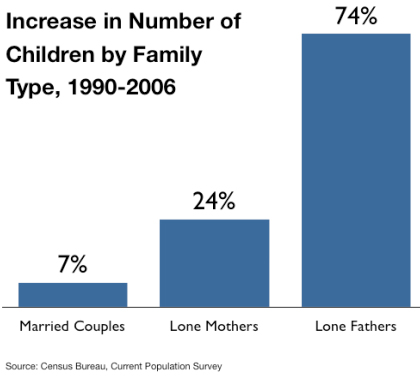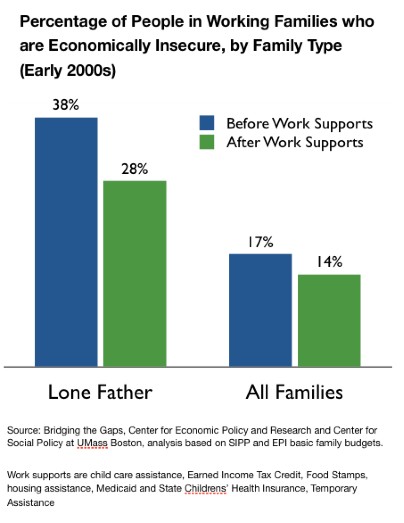Article
Fact-based, data-driven research and analysis to advance democratic debate on vital issues shaping people’s lives.
Center for Economic and Policy Research
1611 Connecticut Ave. NW
Suite 400
Washington, DC 20009
Tel: 202-293-5380
Fax: 202-588-1356
https://cepr.net
Shawn Fremstad and Rebecca Ray
June 12, 2008
An official holiday to honor fathers was initially proposed in 1909 by the daughter of a widowed father. William Smart, a Civil War veteran, raised six children after his wife died in childbirth. Today, lone parenthood is almost exclusively associated with mothers. Yet, families headed by single fathers represent one of the fastest growing demographic groups.
On average, single-father families are better off than single-mother families, but they still experience high levels of economic insecurity, due in large part to the stubborn persistence of low-wage work for one out of every four male workers. Despite overall economic and productivity growth in recent decades, the share of men in low-wage jobs —and the amount they typically earn per hour—is about the same as it was in 1979.
Single-Father Families Among the Fastest Growing Demographic Groups
In 2006, about 4.7 percent of children—3.46 million children—lived in single-father families. Between 1990 and 2006, the number of children in single-father families increased by 74.1 percent. By comparison, the total number of children in married couple families increased by 6.8 percent and the number in single-mother families increased by 23.9 percent. Of the nearly 21 million children living in single-parent families in 2006, about 16.8 percent live in single-father families.
Source: Census Bureau, Families and Living Arrangements, Current Population Survey.

Many Single-Father Families Are Economically Insecure
Among people living in single-parent families headed by a working father, almost 28 percent are economically insecure based on their earnings and any public forms of assistance they receive. We define a family as economically insecure if their income falls below the “basic family budget”—a measure of the basic goods and services needed to “make ends meet”—for where they live. [1]

Public work supports—including the Earned Income Tax Credit, public health insurance (Medicaid and the State Children’s Health Insurance Program), and Food Stamps—play a substantial role in helping single-fathers make ends meet. Before taking public work supports into account, 37.6 percent of people in single-father families are economically insecure. Thus, work supports reduce the share of people in economically insecure single-father families by 10 percentage points.
By comparison, among people in all working family types, about 17 percent are economically insecure counting all sources of income, and about 14 percent are economically insecure before taking public work supports into account.
Among single-fathers who remain economically insecure after taking public work supports into account, those supports close more than two-thirds of the difference between their income and the minimum amount they need to make ends meet.
Source: Bridging the Gaps Project, Center for Economic and Policy Research and Center for Social Policy at the University of Massachusetts Boston, analysis of Survey of Income and Program Participation.
Low-Wage Jobs Contribute to the Economic Insecurity of Single-Father Families
About one in four men work in low-wage jobs. (We define a low-wage job as one that pays less than 2/3rds of the male median wage or $11.11 an hour in 2005.) The typical man working in a low-wage job earned $8.64 in 2005. Women are still more likely to work in low-wage jobs than men—about 36 percent of women workers are in low-wage jobs—but the gap between men and women narrowed. In 1979, nearly 56 of women worked in low-wage jobs. By comparison, the share of men in low-wage jobs actually increased—by just over one percentage point—between 1979 and 2005.
Regardless of gender, the typical low-wage worker today earns about the same per hour, after adjusting for inflation, as they did in 1979. Productivity and real gross domestic product per capita have nearly doubled over the same period, but low-wage workers have not shared in these overall gains.
Source: Center on Economic and Policy Research, analysis of Current Population Survey.
Footnote:
1. This assessment is based on the basic family budgets developed by the Economic Policy Institute.